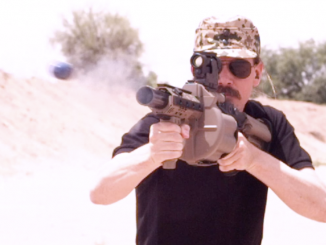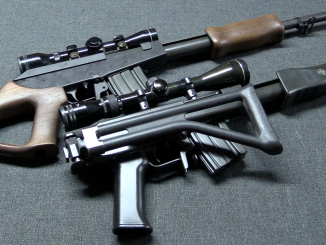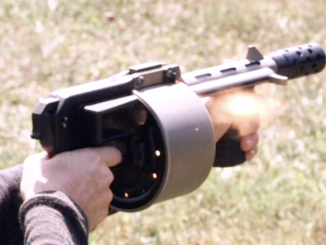The South African company Smith and Beecham was not a large operation, and their most notable product was a .380 caliber compact pistol, of which not more than 2000 were ever made (it was not a success). Experimentally, the company also developed a polymer frame for the Browning High Power, however, and that is what we are looking at today. The weight savings from this are less than one might initially expect, because the High Power was designed with a metal frame in mind. Many of the pin positions and moving surfaces will not work when made of polymer, and so the Smith & Beecham design used a substantial metal insert within its polymer shell.
Only a few were made, because the design simply did not deliver much advantage. The closest it came to production was when the Republic Arms Company submitted a version of it mated with an RAP401 pistol for South African police trials, but it was rejected.




Plastic frame pistols seem to be, with some minor exceptions, an internationally accepted norm. I am not sure if they (the plastic frames) are entirely justified and worth of trouble, part of cutting some manufacturing cost.
If I had to choose a pistol (hypothetically for CC) it would be likely steel framed one. This type of frame may be heavier, but it offers unparalleled integrity and since thin wall steel cast technology is well developed, they may not be that heavy after all. Besides, who would mind little heavier, but steady in hand during fire pistol.
“(…)little heavier(…)”
More time you carry, more mass matter. Also it might be easier to carry lighter automatic pistol in hidden matter, though this matter more in hot climates – where little clothing is used.
High-Power was poor starting point for such redesign two-fold: as already pointed it was designed to be made from steel, but more over it was service automatic pistol, that is mainly carried openly (in holster), so mass advantages have little influence to feeling of its mass.
There exist many polymer-frame automatic pistol, which are used by military, which mean they passed tests, among others for immunity to catastrophe failure. Finally I would be more concerned with combination of particular design of automatic pistol and material used, rather than material alone.
The upcoming Russian service pistol (Lebedev?)… does it have steel or polymer frame?
“(…)Lebedev(…)does it have steel or polymer frame?”
None.
According to https://modernfirearms.net/en/handguns/handguns-en/russia-semi-automatic-pistols/lebedev-pl-15-eng/
Frame is made from aluminum alloy
Another recently developed Russian automatic pistol called Udav
https://modernfirearms.net/en/handguns/handguns-en/russia-semi-automatic-pistols/udav-2/
features a polymer frame with steel insert molded into it.
Now I checked, that at June 12 ТАСС informed that first batch of Udav automatic pistol was delivered for Russian forces for test fielding
https://warspot.ru/14906-udav-poshyol-v-voyska
To give sample of non-polymer frame pistols in current production, I’d pick Lionheart LH9 which is derived form GP35 with addition of double-single firing mode https://www.youtube.com/watch?v=X3H67Nspopw
Another one might be Bersa TPR9 https://www.youtube.com/watch?v=f17xHDGwqPk. Very neat gun. They are both medium or compact size hammer fired hand guns with solid reputation. While better than plastic, however, with not as solid frame as the one out of steel.
Finally, there is the arguably best 9mm steel frame gun… dohttps://www.youtube.com/watch?v=YrScz_hKwwQ
perhaps the only one (although not in production). If life depends on it, do you really care how ‘heavy’ it is?
In the meantime, more security agencies are filling in with Glocks. It must be because striker firing DA I guess.
Denny- The LH9 you linked looks like a quality piece. Interesting lineage- produced by Daewoo, the design seems more like S&W semiautos than P35. Exterior drawbar like Walthers and Berettas. The 3-mode safety resembles the Belgian RDIH.
Decent review of the CZ75 Compact. I agree it is a top-notch pistol that fills the gap (if any) between the BHP and S&W semiautos.
Handling one is like shaking hands with an old friend.
The most obvious advantage of the steel frame today is that it can be manufactured more cheaply and rapidly by CNC machining from stock than a polymer frame, which requires moulding capability.
Investment casting (as per Ruger and Charter Arms) to a basic shape can bring the costs and production time down even more.
It’s interesting to note that in the catalog section of any recent edition of Gun Digest, when you check the polymer-framed vs. steel or alloy-framed versions of such modern pistols as the EAA Witness, etc., the metal-framed versions are invariably cheaper.
I don’t think EAA or whoever would be charging more for polymer-framed guns if they didn’t have to to at least break even.
cheers
eon
I actually found the opposite case with CZ, where the polymer P-07 is $75-200 less than the comparable CZ-75 Omega. This is doubly interesting because the EAA Witness is a CZ-75 clone.
To make injection molding pay off production volume needs to exceed the point where the reduced machine time offsets the cost of tooling. For lower volume production a cast and CNC machined frame is cheaper per unit.
For an older design like the Hi-Power an aluminum frame makes more sense for weight reduction and there are numerous examples of aluminum frame 1911s. On the other hand polymer frame 1911s are rare and unpopular.
Mind that the polymer version of the Witness (Tanfoglio Force) had been in production since 1997, well before the CZ P07. It had even been said that the first batch of metal frame inserts in the P07 had been really made by Tanfoglio.
Very well said Eon
it is all matter of intended slot in the market. If a maker chooses to produce a limited lot of pistols and feels it is best suited to make them (as you said due to technologies available) in metal, he is likely to fulfills his objective.
If in contrary (say someone as Glock) feels the best way to produce quality firearm in quantity for lower cost in polymer, fine. Both have reached presumably their goals.
The srp for the Witness Polymer is $589, that of the Witness Steel is $699.
https://eaacorp.com/guns/handguns?pid=1:tanfoglio&search=&order=i.name&dir=asc&cm=0#tlb
In Italy, where those handguns are made, the difference is even higher. The srp for the polymer model is € 690,00, that of the steel model is € 950,00.
https://www.tanfoglio.it/uploads/docs/listinoprezzipubblico2015.pdf
Mind that the polymer version of the Witness (Tanfoglio Force) had been in production since 1997, well before the CZ P07.
In small series cnc machining could be acceptable, but in big ones, millions a year, like what Glock or HS Produkt makes, plastic injection is beyond any discussion significantly cheaper.
I remember reading article from the 90s that claimed plastic used in that guns is actually more expensive than comparable weight of alloy steel!
I believe that, but probably by today standards and prices, cost came down with all the development.
Looks we are in agreement here and seem able to capture the essence of dilemma. Good discussion!
Agreeing with Joe Crow,
In small runs or a few experimental prototype or bespoke guns, machining from solid is the cheaper way to go.
It takes a largish sale to cover the costs of sinking the dies and setting up the moulding line,
And an even larger sale to make a profit on top of that.
Yes, same as in my response to Storm.
Really dumb questions:
If anyone ever gets to mass-producing an entire functioning firearm from polymer (not including the so-called wiki-weapons), to the point that the only metal used in the design belongs to the cartridge casing, just how practical would it be? And would it somehow evade airport security and be a terrorist’s best friend, as plenty of stupid people fear?
My personal answers:
1. Practical only so long as you’re not shooting lots of rounds for a long period of engagement, as the HK G36 has shown. I suspect a polymer gun barrel wouldn’t last long either.
2. Has ANYONE invented cased firearm ammunition that DOESN’T include metal of any kind!? I’m very certain that a box of pistol cartridges on a person who seems to have no gun anywhere in his luggage would raise suspicion IMMEDIATELY.
This is just a joke post, so feel free to ignore it if you prefer.
1. The G36 is an example of “doing the design before doing the basic research”. In its case, they should have researched the durability and heat tolerance of the polymers they used before starting the design process, let alone production.
I agree a polymer gun barrel is going to be a short service life item. Back in the Fifties and early Sixties, Winchester tried a fiberglass-wound barrel with a thin wall steel liner “bore” on an automatic shotgun. They got about the same results that Eugene Stoner got with a similar barrel structure on the early Hembrug-made AR-10. I.E., it didn’t work.
There is always talk about ceramic gun barrels. Like fusion power, ceramic tubes always seem to be “right around the corner” and “here in ten years”. They just never materialize.
For the foreseeable future, the barrels of projectile-firing weapons will likely at least have metal bores. Somebody may try to wrap that in a boron/graphite composite jacket, but I’m guessing that would cost a lot more than a properly-built all-steel tube.
2. See Plastic-Cased Telescoped Ammunition(PCTA). Also the Dardick “tround”. Either one solves most of the problems of both metal-cased and caseless ammunition, and as a bonus both are easily adaptable to either liquid propellant or monolithic-grain solid propellant, as well as electric ignition.
The only metal rally needed in either one is the projectile itself. We have yet to find any synthetic material that can do a metal “slug’s” job.
It may be a while before either one shows up in small arms, but both are going to be used in high rate of fire automatic cannon in the next decade, as a low-to-medium cost alternative to directed-energy weapons, notably in air defense applications.
cheers
eon
I do not know of successful (although there are cases of composite metal-carbon fibre barrel construction) case of polymer barrel as yet and probably never. The reason is elasticity, this being the exclusive property of metals.
No man, just…no.
Reply to cherndogs initial comment
We have two different, but interlocked matters
1) non-metal barrel
2) non-metal projectiles
regarding 1) there existed cannons made from wood:
https://en.wikipedia.org/wiki/Wooden_cannon
some were metal-reinforced, but I presume currently exists materials which could be used instead of galvanized wire used in:
https://en.wikipedia.org/wiki/Albrecht_Mortar
From more recent development I want to point… Gyrojet, or more generally rocket launchers as they might have less durable barrels than normal cannons of similar size.
Regarding 2) look at Dreyse needle rifle, bullet itself is metal, however there is paper sabot, acting with grooves, rather than bullet itself – such solution means that you need to found material of proper density, without caring for properties crucial for working with barrel grooves.
Mythbusters did wooden cannon bullshit long time ago…
Perhaps is worth to mention this: there are some intricacies when going with polymer frame pistols.
One is that the material of frame may not handle long term exposure to heat and start to expend/ warp. I have heard in past cases happening under heat of South, when stored in enclosed compartment such as glove box; this became real problem and detriment to function.
On the other hand, it is said and it sounds conceivable, that pistols with plastic frames do absorb firing shock better thus making for better handling handgun..
Here is one man’s view who knows handguns
https://www.youtube.com/watch?v=Zl3BKsIgRek
His carry gun is with aluminum frame. Is aluminum frame inferior to steel one? I am not sure. I know that steel and aluminum do not like each other very much, but hard anodizing plus dry film lubricant helps great deal to overcome differences. For one, SIGs of older series cannot be wrong.
Plastics may seem weaker for outside attacks such as heat and solvent, but in fact, all metal frame handguns have plastic members which forming the handle plates which having even worse features than plastics used in plastic framed samples and only those not include vital parts such as springs, levers, trigger bars etc., which covered or protected with plastic grip plates capable to open outside effects when these units go broken or wrapped, could be accepted superior to all plastic frames… Colt 1911, FN GP35, CZ 75 would all be considered in this class and others like, Sauer, Beretta, Walther and similar brands containing important functional parts under plastic grip plates shoud be considered inferior.
The MAB PA-15 had its sear spring held in on the right side by the plastic (actually Bakelite) grip panel. It usually cracked the panel in short order, a trait it shared with the half-century earlier Webley self-loading pistols in .455in WSL and 9 x 20SR Browning, which had their large, V-type recoil springs “retained” in the same way.
Fortunately, pistols like the 1911, Browning HP, and etc. can replace their plastic grip panels with a remarkably inexpensive, durable and actually quite attractive material.
Wood.
cheers
eon
Thanks Eon… In fact, pistols like Colt 1811, FN GP35 and CZ75 all can be efectively used with broken or no grip panels. This is what I want to point out. Whereas pistols like Walther PP/PPK-P38, Sauer models, Beretta 92 etc.. can not be safely and effectively used without grip panels.
So they becomes “superior” by putting aluminium grip panels on them…
If the grip panels are accepted solely as a protection unit covering some vital moving parts, yes it becomes superior, but if they were for shooting comfort… No… Especially at heat department.
There is one more thing which is less than desirable with plastic frames. This is the fact that there are typically no post-molding operation (which would reduce economical viability of them in first place) made to them. Therefore, designer must present some method to locate small parts as you mention into some sort of metal insert. As I happen to be in past a part of design team, I remember what is involved.
This is a good point !
One local gun, hs produkts first product, had grips made out of very fragile plastic, and supposedly most who carried it in the field, ended up quickly with duct taped pistol grips, especially in cold weather.